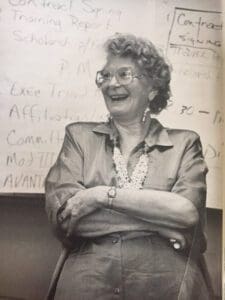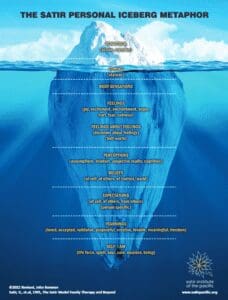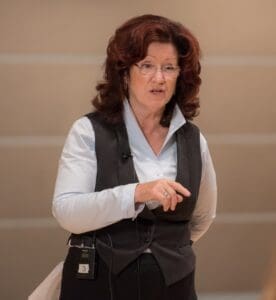Five Things Virginia Satir Would Tell You About the Therapeutic Process
Council for Relationships is known for couples and family therapy since 1932. But who discovered and developed Family Therapy? Virgina Satir is considered the Mother of Family Therapy. Her findings and therapeutic process remain highly influential for therapists. Read on the learn more about Virginia Satir and the five things she would tell you about the therapeutic process if she was alive today.

Virginia Satir is known as the “Mother of Family Therapy.”
Who is Virginia Satir?
Virginia Satir was born into a large farming family in rural Wisconsin in 1916. She had a complicated family life from the start, having to navigate around her father’s alcoholism and her mother’s fanatical religious beliefs. When Satir was five she developed appendicitis, which caused her to be hospitalized for several months. Perhaps these early complications in her life led her to become interested in the emotional interactions within families from a young age.
Satir’s career began in 1950 with a private practice in Chicago, where she discovered her gift for working with families. In 1959 she co-founded the Mental Research Institute (MRI) and in 1962, she created and led the first Family Therapy training program.
As a student of experiential therapy, Satir was driven to focus more on individuals and their emotions than on theories and interactions. Often described as “warm and genuine,” she was well known for using her “large” personality to connect with people and disarm them. The following are the five most powerful parts of her therapeutic approach.

In 1916, Virginia Satir was born in Neillsville, Wisconsin (pictured here).
1. Touch is powerful*
Satir would often demonstrate her theories to families using touch as well as words.
In one well-known case that involved two little boys who had been abused by their mother and were struggling to express their emotions without using violence, Satir showed their father and stepmother the difference between touching to “punish” and touching to “protect.” She initially used her own forearm as a place for the parents to notice and practice their touch before she encouraged them to try it on each other. Satir highlighted that touch to protect sets limits and softens more easily while touch to punish remains hard until it ends. She noted that the boys had learned hate through touch and now needed to learn love through experiencing touch as well.
As this example demonstrates, she regularly invited physical touch with clients (held hands, gave them a hug, demonstrated different ways of care through touch) and encouraged them to practice healthy touch amongst each other.
*Touch must always be consensual and is not always appropriate for therapeutic settings.

Virginia Satir started her career at the Illinois Psychiatric Institute in the 1950s. Today the institute is part of the University of Illinois Chicago.
2. Don’t confuse the “instrumental” and “expressive” functions of emotions
Satir wanted families to understand that emotions are instruments that express needs.
She felt that families tended to punish their children for expressing their overwhelming emotions, which led to blunting and hiding those emotions (and the needs they express) later in life.
Learning how to see emotions as instruments, as well as expressions, allows everyone in the family to be more curious about the cause of the emotions and how to address them.

The Satir Model of Change was originally developed by Virginia Satir.
3. Don’t be afraid of the “chaos stage”
In Satir’s loose outline of her therapeutic model, she identified the following as the three stages of therapy:
- Joining stage
- Chaos stage
- Integration stage
Therapists create a solid base of trust and understanding with their clients in the joining stage.
In the integration stage, therapists integrate the new problem-solving techniques, which create feelings of satisfaction and hope for the clients.
It is the middle stage, the chaos stage, that is often the hardest on the clients. In this stage, old ways of coping are dismantled, and the pain and confusion caused by underlying issues are revealed. This can be the moment where clients question therapy as they feel “worse” than they did before they started. It is only by leaning into the process and making it to the integration stage that they can see the benefits of this painful middle stage.

The Satir Personal Iceberg (courtesy of the Satir Institute of the Pacific)
4. Everyone is working towards connection, even when they are acting out
People say Satir thought of individuals and their relationships like icebergs.
The behaviors they exhibited were just what showed above the surface. Underneath the surface were things like feelings, perceptions, and coping mechanisms. It was important to Satir that family members begin to see themselves and one another like this as well. She labeled even the worst behaviors, like violence and hateful words, as attempts (albeit maladaptive ones) by individuals to connect with others.

In the 1960s, Virginia Satir accepted a position as the head of training at the Human Potential Development Program at the Esalen Institute (pictured here in California).
5. Identifying hopes and dreams to work towards is more important than getting rid of “bad behaviors”
Satir wanted to move people away from complaining and towards finding what they wanted to work for.
She highlighted the positive intentions that individuals had in the family, even as they struggled to change their behaviors. Satir believed that reinstalling hope in families and examining old dreams, as well as highlighting new dreams that may be emerging, creates the necessary space for positive change. She encouraged families to let old behaviors fall away naturally as new healthy ideas were explored in service to the family’s dreams.

Virginia Satir’s legacy continues to influence therapists today, most notably the work of Dr. Sue Johnson (pictured here).
How does the Virginia Satir therapeutic process continue to influence therapists today?
While Virginia Satir’s life and career are plenty interesting, it was her gender as well as her approach that made her a particularly important clinician in the history of Family Therapy.
At the time that she was emerging as a major figure in her field, Family Therapy was focused on concrete theory, systemic thinking, and interactions (as opposed to emotions). Satir led more with intuition than “logic” and used only a loose model of theory to guide her. This was in stark contrast to other contemporaries in her field who focused on detailed models with more specific interventions, such as Murray Bowen (Family Systems Theory), Salvador Minuchin (Structural Family Therapy), and Jay Haley (Strategic Family Therapy).
It is easy to imagine that Satir faced much criticism from others as one of the only women leaders in her field and an individual who chose to focus on emotions at a time when they were deemphasized. But her work spoke for itself. She helped thousands of families and trained many future clinicians.
It is an impressive and notable feat that, in the face of all that was against her, she was able to stick to her own beliefs and form her own style and school of thought. Her impact was vast, influencing past clinicians like Ivan Boszormenyi-Nagy’s (Contextual Therapy), and continues to impact clinicians today, most notably Sue Johnson (Emotionally Focused Therapy).

Staff Therapist Sarafina Kietzman-Nicklin, MFT
About the Author
Sarafina Kietzman-Nicklin, MFT is a CFR Staff Therapist in Philadelphia and Paoli, PA. She is currently accepting new patients. Click here to book an appointment.
You may reach Sarafina at skietzman-nicklin@councilforrelationships.org or 215-770-2334 ext 4351.
See our Therapist & Psychologist Directory to find a different CFR therapist or psychiatrist near you.
About CFR’s Women’s Psychological Health Services
Women’s Psychological Health Services (WPHS) connects specially-trained clinicians to help women navigate mental health through all the stages of their lives, including during pregnancy and postpartum.
Click here to learn more about WPHS.
More from CFR
Philadelphia Therapist Accepting New Patients: Sarafina Kietzman-Nicklin
